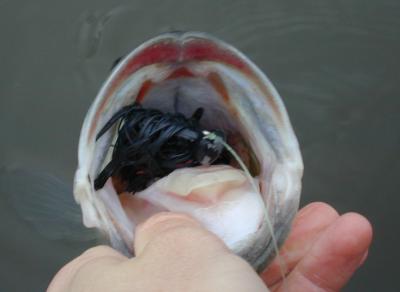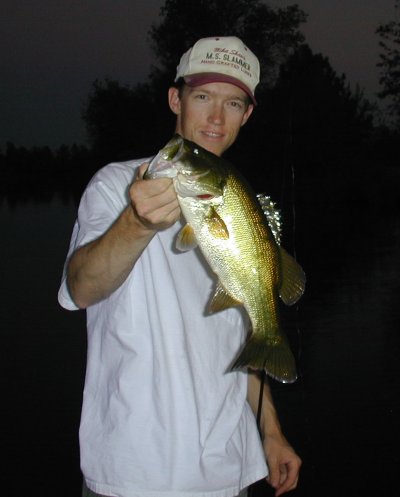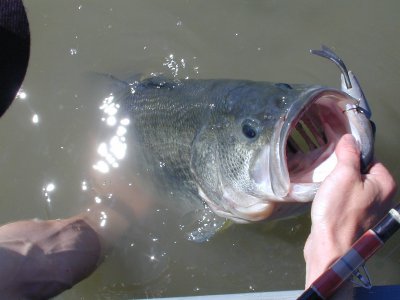So far we have talked about paying attention to detail in regards to tackle and conditions. Now let's talk about the fish themselves.
Sometimes it makes me laugh thinking about the fact that success in fishing, my passion and favorite hobby is largely determined by when a fish wants to eat something. You can do everything just right, but if the fish don't feel like eating during that one moment in time when your lure or bait passes by, you aren't going to catch them. It's a stupid thought, but one worth thinking about.
So let's talk about what we can learn by observing the fish. I'm going to talk mostly about bass here, but you can learn about any type of fish by either seeing it in the water or catching it and inspecting it up close.
To see the fish you're fishing for, you have to have polarized glasses. It's not even optional. I believe a good pair of polariods can add 30% to your underwater vision. Always keep your eyes out for fish, and when you see them, make note of what they are doing. Here's some typical behaviors I've seen and what I interpret them to mean.
If you observe bass that are cruising at a certain depth, those are typically going to be hard fish to catch. I do believe that cruising fish are often times feeding fish, but I believe that bass, especially big bass are cruising in an effort to flush food out rather than trying to wait and ambush food. The only time I've caught fish that I've watched cruising is when I've been able to cast well in front of them without them having any clue that I was there. That's really hard to do! And I have not caught very many like this. I also believe that the closer a cruising fish is to the bottom, the more likely it is to bite. Fish that cruise at mid-depth are very tough. Fish that are right along the bottom seem to be more agressive.
Sometimes you will see bass sitting right on the surface like in the top of a tree or by a bouy. Surface fish like this are also very tough to catch. I actually think that surface oriented bass are positioning this way as a protection mechanism. Being close to the top allows them to see dangers (like a bass fisherman) from far away. It may be that the fish are also using these spots to ambush other fish, but I have never seen a surface suspended fish eat anything, so I am kind of skeptical about that. Fish like this may also just be enjoying the warm suface water. It's a tough call, but what I do know is that these fish are tough to catch and usually not worth the time.
To me, ambush fish are what I'm looking for most of the time. If you see fish that have their tail parked in some kind of cover and their nose pointing out, those are the fish to back off and fish for. It's also very worthwhile when fishing cover to try to picture where a fish would be if it was going to be ambushing something that came by. If you don't know a lake, it can be worthwhile to run the bank super shallow with your boat and see if you can spook some fish out. This can tell you a lot about what is going on.
Schooling fish can be good targets, just like ambush fish. At most lakes you'll see schooling fish after the spawn when the shad start to come up shallow and do their spawn. Schooling equals competition and competition equates into bites. Fish will also school in the pre-spawn but these kind of fish are very hit or miss. Usually what triggers pre-spawn schooling fish to bite is bad weather. It seems like bad weather signals to large female bass that they are not going to be able to spawn for a while longer, so they may as well start eating like crazy again. If you see schooling fish one day in the pre-spawn that won't bite, and three days later it's raining and nasty ... be every happy.
So that's all pretty convetional wisdom above about your typical bass behavior. What's important is to keep your eyes open and when you see the fish, ask yourself what the fish is doing and is it worth fishing for that kind of fish.
The next topic to discuss is what we can learn from the fish themselves. When you get a fish in the boat, take a good look at it and better yet, take a picture of it. What a fish eats often influences how it looks.
One of the most obvious things you can figure out is if a bass is eating crawdads. Bass, especially in rocky areas, have to work hard to get crawdads. Their heads get beat up digging in the rocks and their mouths get red from crushing the hard shell crawdads. Their teeth will also get worn down when they do this. Here's a fish that has probably been eating crawdads:

Fish that are eating baitfish have to chase down their meal. If you're catching fish with really clean fins, white mouths and sharp teeth, they're probably on some kind of bait. Another sign that fish are on bait is that they look kind of lean and tall. I don't have a good mouth pic of a fish on bait, but here is generally how fish like this look. This particular fish was probably eating bass fry and bluegill and was caught on a spook.

Fish that are eating trout are likely to be big, fat, white mouthed, sharp toothed and have a bulging or odd shaped belly. That's what trout fish look like. The thing about these kind of fish is that if you do catch them, it will usually be on a trout bait of some sort, so the fact that they were eating trout won't really tell you much :)

No matter what species you are fishing for, it's worth it to spend the time to inspect the fish and try to learn what they are doing in the water, and what they are eating.
